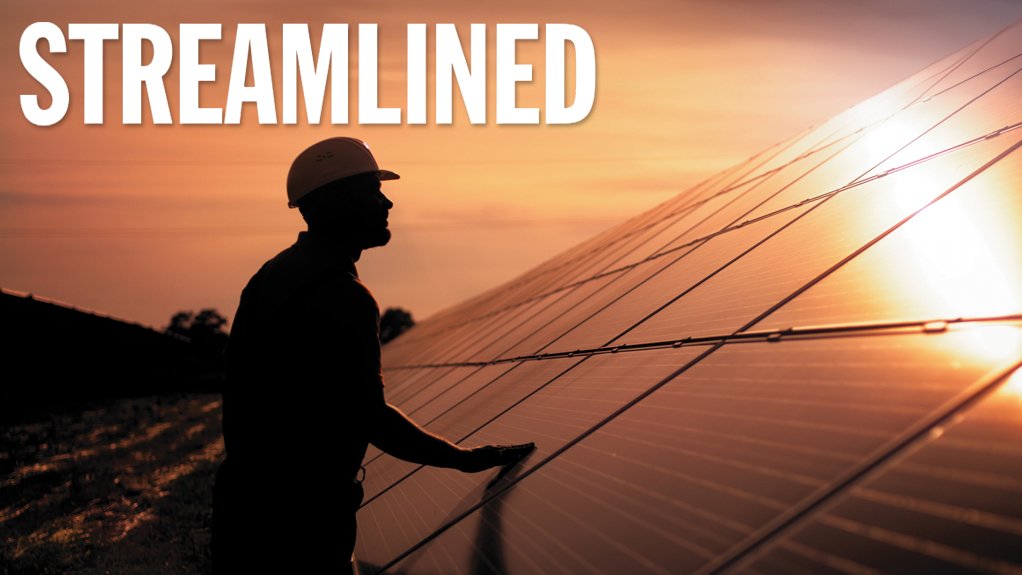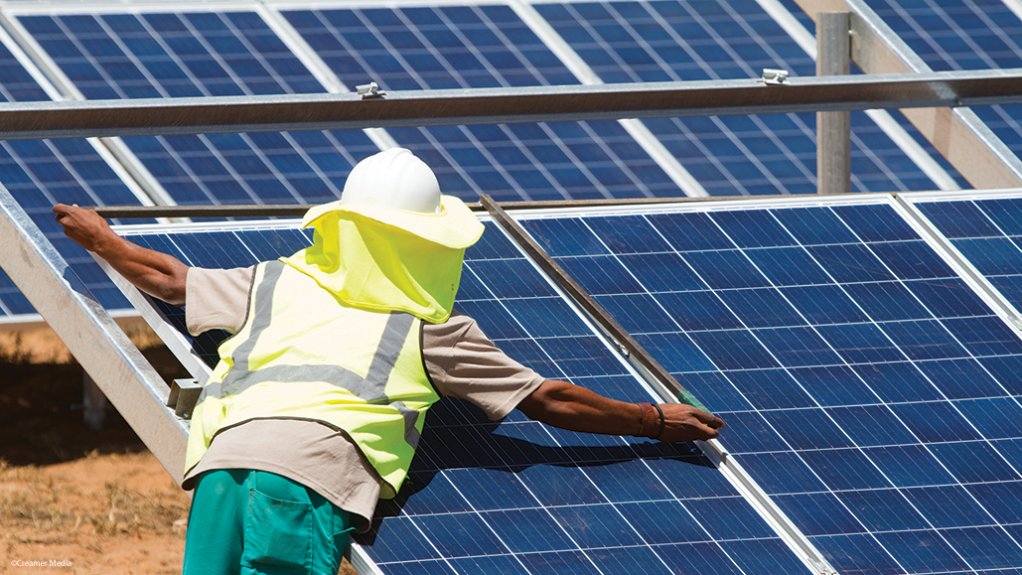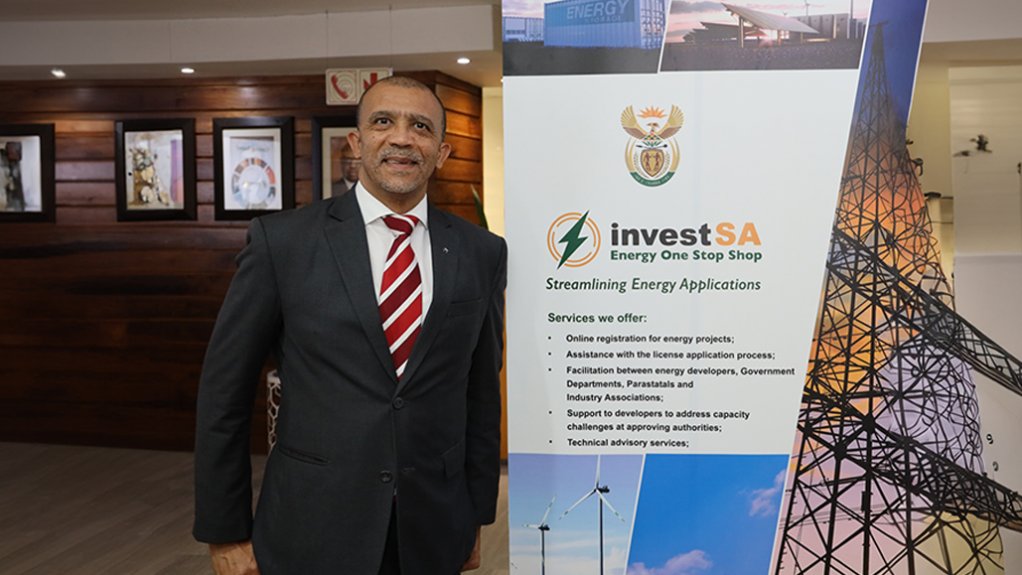Inside the Energy One Stop Shop and its drive to fast-track electricity projects





EFFICIENT ENERGY ONBOARDING Developers will be able to submit their applications for energy projects more efficiently
LESTER BOUAH We have the ability to escalate projects and make sure we’re operating within the legal framework, and not circumventing the processes within that legal framework
MINISTER EBRAHIM PATEL The EOSS was officially launched by Trade, Industry and Competition Minister Ebrahim Patel on July 27 this year
The Energy One Stop Shop (EOSS), officially launched by Trade, Industry and Competition Minister Ebrahim Patel on July 27, is in the ramp-up phase of a four-stage process aimed at fast-tracking the regulatory approvals required for new self-generation projects and projects that will be connected to the local power grid.
The creation of the EOSS is an acknowledgement by government that the red tape around energy projects is onerous, particularly as applications need to be submitted to as many as 14 different government departments, says EOSS chief director Lester Bouah.
The EOSS initiative – launched by investment promotion organisation InvestSA, which is part of the Department of Trade, Industry and Competition (dtic) – is already overseeing several applications.
The EOSS is capacitating itself with the help of several departments and partners to meet its objectives.
The first stage of the process has been completed. This stage involved establishing the EOSS facility with dedicated personnel, a website outlining the requirements for all application processes, a portal on which developers can register their energy projects, and a mapped process showing the progress of projects in the approval process.
Having commenced Phase 2 in the lead-up to the launch of the EOSS, the EOSS initiated the scoping of provincial and municipal approvals to standardise and streamline processes, and recommend capacity building initiatives where required.
Phase 3 entails implementing one electronic application process with automated feedback.
In Phase 4, the full project will be in place, dealing with immediate blockages and considering a wider reform programme.
“We’ve developed a website with a portal, where energy project developers can register their projects. We’ve also developed a tracking tool to track and facilitate project approvals with competent authorities.
“We’ve also taken over a list of 114 projects that were previously tracked and facilitated by the Embedded Generation Task Team located under Operation Vulindlela in the Office of the Presidency. These are at various stages of development,” explains Bouah.
The EOSS continually engages energy developers who have used the portal, and encourages more developers to do so to provide feedback to improve the process.
Acting on Feedback
Bouah highlights the positive feedback the EOSS has received from developers, many of whom stressed that there had previously not been any mechanisms to provide input or receive updates.
“They were submitting applications to various government departments, but weren’t getting regular feedback on how their applications were being processed.
“We escalate their project challenges to the relevant departments, obtain project progress, identify any shortcomings, and constantly communicate these to developers.”
To get feedback from departments quickly, the EOSS needs dedicated people from every department with whom to discuss applications.
“Directors-general have assigned staff from each department to sit in a grouping called the technical working group of the EOSS, and the group meets on a regular basis,” he adds.
Operating Philosophy
Given the difficulty of requesting officials from multiple departments to be constantly available to assist with applications, particularly in a context where workflow is inconsistent, the EOSS has opted for a model where in-house administrators deal directly with applications.
The administrators then communicate with departmental representatives on the technical working group to secure technical advice and escalate project delays to departmental offiicals dealing directly with the applications.
“Department representatives who form part of the EOSS are, thus, based in their departments, but are agile enough to still play a critical role in the EOSS.”
Currently, the EOSS has about six staff members, including Bouah.
The setup means that there has been no need for funding for additional infrastructure for the EOSS, and that in-house resources from the dtic were committed to the EOSS .
“We do, however, have funding support from the International Finance Corporation, the World Bank, and the Foreign, Commonwealth and Development Office of the UK. They’re helping us in mapping the processes at national and municipal levels that will be implemented in phases two and three.”
The EOSS is also working with the South African Local Government Association to capacitate local municipalities, as many do not have the necessary skills and knowledge to evaluate energy projects and the economic value of such projects in a fiscally constrained environment.
Phases & Mapping
Ultimately, the EOSS, flowing from the mandate received from the Presidency/National Energy Crisis Committee/Natjoints is envisaged to become a single-window application process, Bouah notes.
“Departments are competent authorities, supported by promulgated legislation, and they need to agree to how this objective will be achieved.
“Therefore, at present, it is not about taking the application process away from the departments, but rather linking these processes.
“In these developmental phases, we are engaging departmental information technology departments so that we can create an application programming interface or something similar to link these processes,” he explains.
Once an application is submitted, it is linked back to the EOSS, which is notified and then starts to track the progress on the project.
There were previously overlaps across different departments, as energy developers were required to go through the same process for different departments.
“There’s an opportunity to streamline that, so when a developer submits an application, they don’t have to submit details again, it’s already captured on the system.
“We’ve mapped out the process, and we’ve developed a checklist in conjunction with departments of all the approvals,” he notes.
By the end of the third phase, the EOSS will have implemented an electronic system, and will migrate away from the current manual model.
“An electronic system will enable developers to come through one window [and] register their applications, and we can facilitate the speedy processing of applications.”
The EOSS formed a partnership with the Companies and Intellectual Property Commission, which has offered its in-house support engineers to help build an electronic tracking system.
Additionally, the EOSS received commitment in its memorandum of understanding with the Energy Council of South Africa, which will also contribute to facilitating private- sector involvement.
The council and applicable energy associations further committed to advising on the EOSS’s tracking and monitoring methodologies, and what is needed to improve the energy project application process, based on feedback from private-sector association members.
“We’ve been able to leverage support from the private sector – both financial and nonfinancial, as government is fiscally constrained.”
Administrative Conduit
Bouah describes the role of the EOSS as being “an administrative conduit and advisory service” that can help developers address gaps in their applications.
Consequently, developers can submit their applications for energy projects more efficiently.
Feedback can also be provided before submission, which provides an opportunity to correct errors before the submission of applications.
“This can help ensure that applicants are almost foolproof, and that the timeframes set, depending on legislation, will be met because we have brought all the parties together.”
This collaboration between the EOSS and relevant government departments will also contribute to advising developers on aspects such as ideal locations. This could be the case if a developer wants to develop a project in a region with constrained grid capacity, and developing the project in a more suitable location could be advised.
Bouah says the EOSS is likely to be a temporary measure, as its immediacy in mitigating South Africa’s challenges with Eskom and energy supply is required now.
The EOSS has, however, together with the World Bank, started to develop standard operating procedures to be used in the EOSS. These standard operating procedures will be made “as generic as possible”, so that they can be adjusted if needed for dealing with similar challenges in other local sectors going forward.
“We’ve also shared these with different departments. Some don’t have these procedures, but others do, so we’ll work with those departments to dovetail their process with ours.”
Harmonious Collaboration
Bouah highlights the benefits of collaborating with the required departments efficiently, as this helps to facilitate the different applications required for different departments for energy projects.
“With the Department of Home Affairs, as an example, when project developers may need to bring in experts, the dtic has a unit that deals with Home Affairs on business visas and critical skills visas to bring in the required expertise.
“This facilitation between us and departments facilitates the process for developers coming in to implement their projects as quickly as possible.”
As Eskom is part of the EOSS working group, the EOSS can communicate directly with the utility to address issues about connecting the projects.
“Eskom has asked the EOSS to have a special tab on our tracking tool for their projects, so we’re now looking at those projects they’re bringing onto the system.
“We want to look at projects that don’t have lengthy timelines, as we need projects imminently done to alleviate energy supply challenges. We can put those projects onto the portal and tracking tool, and fast-track these projects in conjunction with Eskom.”
Bouah stresses the importance of adhering to checks and balances within the process of onboarding local energy projects, and correctly navigating through the necessary legal and regulatory processes.
“We’re reporting to various structures, as well as directly to relevant Ministers. We are cognisant of the need to move energy projects forward at speed.
“We have the ability to escalate projects and make sure we’re operating within the legal framework, and not circumventing the processes within that legal framework.”
The EOSS will use the dtic one-stop shops in other provinces to receive project applications, and determine whether they should be dealt with at a provincial, municipal or national level, based on the size of the project.
“Ultimately, we’re trying to create a more conducive environment for business and investors,” he concludes.
Article Enquiry
Email Article
Save Article
Feedback
To advertise email advertising@creamermedia.co.za or click here
Comments
Press Office
Announcements
What's On
Subscribe to improve your user experience...
Option 1 (equivalent of R125 a month):
Receive a weekly copy of Creamer Media's Engineering News & Mining Weekly magazine
(print copy for those in South Africa and e-magazine for those outside of South Africa)
Receive daily email newsletters
Access to full search results
Access archive of magazine back copies
Access to Projects in Progress
Access to ONE Research Report of your choice in PDF format
Option 2 (equivalent of R375 a month):
All benefits from Option 1
PLUS
Access to Creamer Media's Research Channel Africa for ALL Research Reports, in PDF format, on various industrial and mining sectors
including Electricity; Water; Energy Transition; Hydrogen; Roads, Rail and Ports; Coal; Gold; Platinum; Battery Metals; etc.
Already a subscriber?
Forgotten your password?
Receive weekly copy of Creamer Media's Engineering News & Mining Weekly magazine (print copy for those in South Africa and e-magazine for those outside of South Africa)
➕
Recieve daily email newsletters
➕
Access to full search results
➕
Access archive of magazine back copies
➕
Access to Projects in Progress
➕
Access to ONE Research Report of your choice in PDF format
RESEARCH CHANNEL AFRICA
R4500 (equivalent of R375 a month)
SUBSCRIBEAll benefits from Option 1
➕
Access to Creamer Media's Research Channel Africa for ALL Research Reports on various industrial and mining sectors, in PDF format, including on:
Electricity
➕
Water
➕
Energy Transition
➕
Hydrogen
➕
Roads, Rail and Ports
➕
Coal
➕
Gold
➕
Platinum
➕
Battery Metals
➕
etc.
Receive all benefits from Option 1 or Option 2 delivered to numerous people at your company
➕
Multiple User names and Passwords for simultaneous log-ins
➕
Intranet integration access to all in your organisation




















